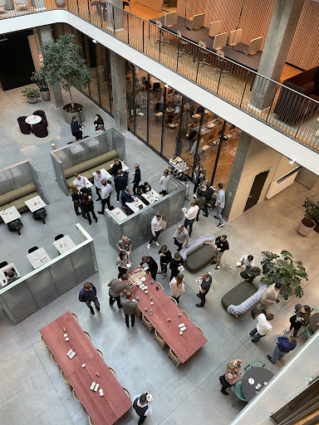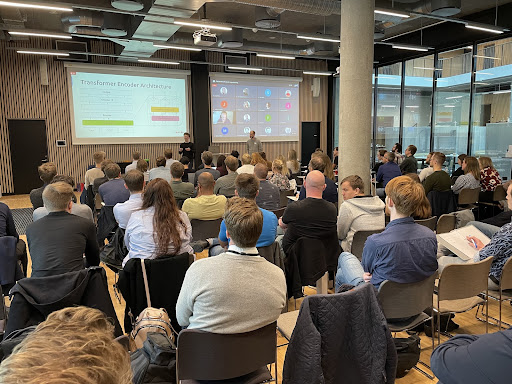During the past five years, Visma’s AI conference has evolved from a group meeting with 24 participants to a full-fledged conference with 300+ signups, almost doubling in size every year.
Although at a larger scale, the ambition is still the same: gather people who develop, implement, or sell AI systems to share news and knowledge. Following an entirely virtual conference last year, we were happy to offer a hybrid event with online and physical attendance. A whopping 90 people gathered in the Copenhagen office!

From football to cyber-security and software operations
Thanks to the size of the AI community and the number of AI solutions in Visma, the whole day could have easily been filled with only internal talks. However, external influence is essential and exciting. Boy was it interesting when Veo presented their AI-based sports cameras and video analysis systems, and Muninn presented the technology behind their AI-based cyber security systems.
The rest of the day was all about Visma-produced AI. The first transition was natural: from Muninn’s systems for anomaly detection in cyber security to anomaly detection in software operations infrastructure by Stian Vale. Stian showcased how he and his team have built a system that can pick up signals of an upcoming incident before it happens. Like a heart monitor that can pick up signs of an upcoming heart attack—just for servers. A vital addition to a software operations toolbox.

AI for healthcare
And when talking about healthcare, we also had that on the agenda. Because in Visma, we deliver solutions to all kinds of organisations —from one-person companies to governmental institutions. And we, of course, apply cutting-edge technology in all segments.
Deepak Tunuguntla talked about how he and his team in Ecare in the Netherlands have developed a system that, from written natural language, can extract information, like blood pressure and other vitals, that can go into structured health records.
Following the technical talk from Deepak, Miina Hölttä from Domacare reminded us of the importance of ethics in AI in general and healthcare in particular. This is a field that Miina has researched.
Using machine learning to simplify administrative work
While the above example is from the large enterprise and government segment, we had Alexander Jasper from Dinero show how they have used machine learning to simplify the administrative work for small companies.
By using Visma’s internal components Smartscan and AutoSuggest, Dinero has made booking an invoice as easy as drag, drop, click, click. You can have an invoice booked on the correct account with dates, amounts, and other details extracted from a picture or PDF with that few actions.
And later in the day, we got to hear the details behind Smartscan: the natural language processing service extracting information from documents. This presentation was delivered by Christoffer Øhrstrøm and Lasse Reedtz representing Visma’s Machine Learning Assets team.

Technology and tools for the future
Most of the presentations were of services already up and running, but we also got to see displays of both technology and tools that we may use in the future. Anders Vandvik and Martin Olstad from Visma Resolve showed their exciting work within automated forecasting in the logistics and inventory area.
We forecast that forecasting will be a thing in many Visma products in the future. On the tooling part, Joachim Aae from Visma bWise and Jakob Ladekær from Kapacity showed machine learning tooling. Jakob presented a customer case where he and the team have used transfer learning to build custom image applications for electricians and power companies.
No Visma AI Conference is complete without getting a high-level overview of the status of AI inside and outside of Visma. Kejsi Gjordeni presented the results from her mapping of AI initiatives in Visma.
She found that we currently have a staggering 239 active AI projects, increasing 34% from 2020. And no, it’s not just proof of concepts—130 of these projects are in production! Tim Harrison from Hg helped us get an overview of the global trends.
All in all, it was a day packed with knowledge sharing, inspiration, and new connections. Our AI journey has only started: to infinity and beyond! 🚀

